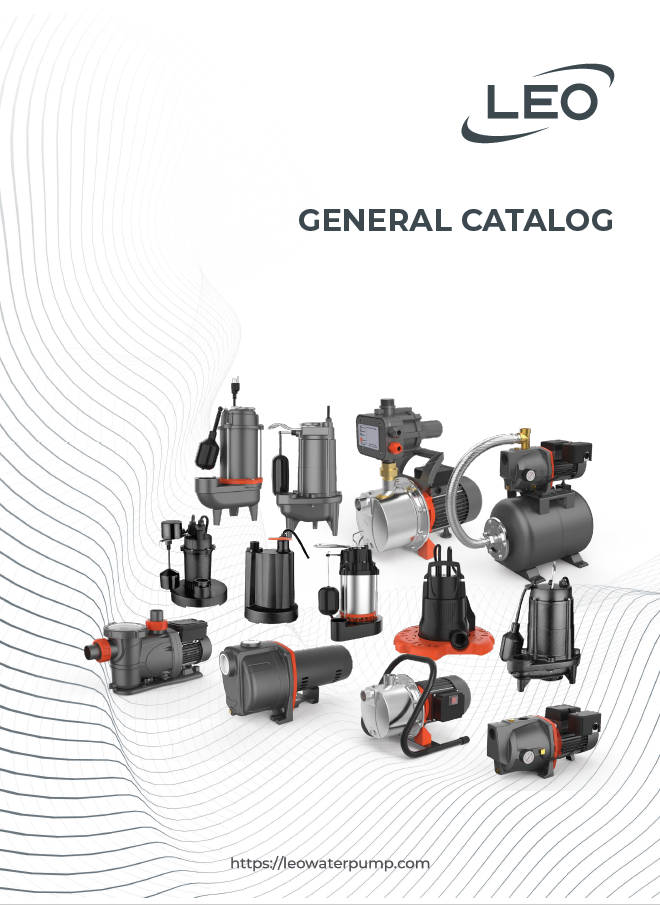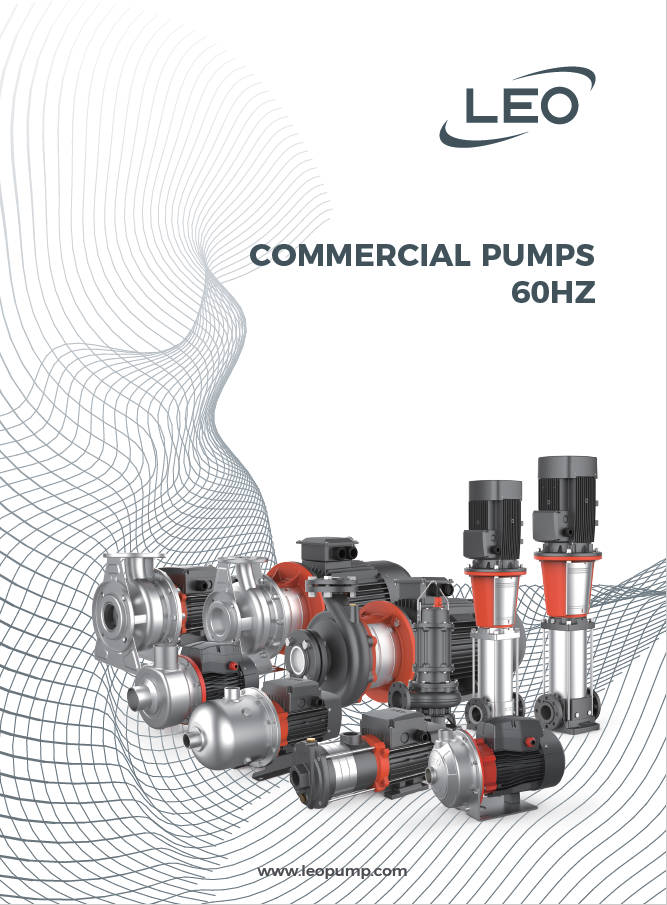
FAQs
How Do I Select The Right Pump Model?
Please refer to our pump selection software: https://model.leopump.com/industry or contact us by email: infous@leopump.com
As is well known, all pumps operate with water, with different flow rates and pressures. However, when selecting pumps, the first question we must ask ourselves is: What is the purpose or application of the pump? There are different types of pumps (domestic and commercial), depending on their positioning, maximum pressures, and required flow rates or flows, but depending on their application and use, Leo Pump has classified the main huge groups of DOMESTIC pumps into: utility pumps, submersible pumps, sewage pumps, deep well pumps, effluent pumps, and circulation pumps.
1.UTILITY PUMP: is a portable and versatile tool for quickly moving water from one place to another. It is used for tasks such as draining flooded basements, swimming pools, or water heaters, as well as for transferring water for irrigation or ponds. These pumps can be submersible or non-submersible, come in manual and automatic models, and are ideal for temporary, non-permanent water removal or transfer jobs.
2.SUBMERSIBLE PUMP: ideal for deep wells, drilling, irrigation, and industrial applications. They can also be used to drain flooded areas such as basements and construction sites, remove water from swimming pools, and manage wastewater and sludge in treatment plants. Designed to operate underwater, they are efficient and quiet, take up little space, and do not require priming, making them a highly versatile option for a variety of pump needs.
3.SEWAGE PUMP: It mainly transports wastewater from a building to the main sewer system or a septic tank, especially when gravity cannot move due to low-lying areas such as basements.
4.DEEP WELL PUMP: It is used to extract groundwater from deep aquifers and transport it for various uses.
5.EFFLUENT PUMP: Transfers partially treated wastewater containing small solids from a septic tank to a drainage field, mound, or other discharge point when gravity is insufficient for drainage.
6.CIRCULATION PUMP: It moves fluid within a closed system, such as hot water recirculation systems, to maintain constant flow, pressure, and temperature.
Once we are clear about the intended use of the pump, we need to know the path and location where the fluid will be transported. To do this, we need to know the height of the water column (required pressure) and the amount or mass of water we want to move in a given time interval (required flow rate).
Finally, click on the PRODUCTS tab, and if you have any questions or cannot find the model(s) that suit your needs, please contact us by email: infous@leopump.com.
Our commercial line at LEO PUMPS can be classified by use and application, with the following models available in terms of characteristics and uses:
Vertical In-Line Pumps, Vertical Multistage Pumps, Horizontal Multistage Pumps, Centrifugal Pumps, End Suction Pumps, and Submersible Pumps.
1.Vertical In-Line (Application):
A.HVAC Systems
B. Water supply systems. Filtration and transfer in waterworks. Pressure boosting in the main pipe.
C.Washing and cleaning systems, boiler feed, cooling water circulation, water treatment systems, auxiliary systems, and Support equipment.
D.Fire protection systems.
2.Vertical Multistage (Application):
A.Suitable for transferring low-viscosity, non-flammable, non-explosive liquids that do not contain solid particles or fibers.
B. Water supply and drainage for high-rise buildings. Filtration and transfer in water treatment plants, and pressure boosting in the main pipe.
C.Washing and cleaning systems, boiler feed, cooling water circulation, water treatment systems, auxiliary systems, and Support equipment.
D.Ultrafiltration systems, reverse osmosis systems, distillation systems, separators, and swimming pools.
E.Agricultural irrigation: sprinkler irrigation, drip-feed irrigation.
F.Food and beverage industry.
G.Fire protection systems.
3.Horizontal Multistage (Application):
A.Applicable to domestic water supply.
B.Equipment support, pipe pressurization, garden irrigation, vegetable greenhouse irrigation, fish farming, and poultry farming.
C.Industry and mining,
D. Water supply and drainage for businesses and high-rise buildings, central air conditioning and centralized heating circulation systems, etc.
4.Centrifugal Pumps (Application):
A.It can be used to transfer liquids with slightly corrosive health requirements and containing impurities, etc.
B.Suitable for industrial and domestic sewage systems, food and beverage processing, agriculture, pumping water from rivers and lakes, etc.
C. Can be used at full power without overloading the motor.
5.End Suction Pumps (Application):
A.Water supply: filtration and transfer in water treatment plants, regional water supply, and pressure boosting in main pipelines.
B. Industrial pressure boosting water systems, cleaning systems.
C.Industrial water supply: boiler feed, cooling systems, air conditioning, transport of slightly acidic and alkaline liquids.
D.Water treatment: distillation systems, separators, swimming pools.
E.Agricultural irrigation, petrochemical industry, medicine and sanitation, etc.
6.Submersible Pumps (Application):
A.Civil engineering
B.Mines, quarries, coal ore & slurries
C.Sewage treatment plants
D.General pumping purposes
Once you have classified the type of pump you need and know the pump’s operating point, refer to our pump selection software: https://model.leopump.com/industry or contact us by email: infous@leopump.com
What Information Do I Need Before Choosing A Pump?
The first step is to confirm the application scenario.
For residential pumps, focus on water demand, well/source depth, pressure, flow, power supply, and ease of installation/maintenance.
For commercial pumps, focus on fluid characteristics, pressure, flow, system head/flow requirements, energy efficiency, compliance standards, and long-term reliability.
Can I Use The Same Pump For Both Residential And Commercial Use?
How To Install A Shallow Well Jet Pump?
Please review the manual for more details. Here are some common steps and tips.
1. The Well Preparation
Ensure the well casing is clean and free of debris.
Drop the suction pipe into the well with a foot valve + strainer attached at the bottom (keeps prime and filters out debris).
Make sure the suction pipe is straight, airtight, and below water level.
2. Suction Line Setup
Use 1¼” suction pipe (minimum) for better flow.
Seal all threaded connections with Teflon tape or pipe compound.
Keep the suction line as short and straight as possible (fewer elbows).
Install a check valve close to the pump inlet (if not built in).
3. Pump Location
Place the pump on a solid, level surface near the well.
Protect it from rain, flooding, and freezing (pump house or basement is ideal).
Keep within a 25 ft vertical lift limit from the water source to the pump.
4. Discharge/Pressure Side
Connect the discharge outlet (usually 1″) to your pressure tank inlet.
Install a pressure gauge and pressure switch on the discharge line.
Add isolation valves so you can service the pump later without draining the system.
5. Electrical Wiring
Confirm the voltage on the pump matches your supply (110V or 220V).
Follow the wiring diagram on the motor cover.
Always connect a ground wire.
Use a dedicated circuit breaker if possible.
6. Priming the Pump
Remove the priming plug on top of the pump housing.
Fill the pump and suction line completely with clean water.
Replace the plug tightly.
Check that the foot valve holds water (no leaks).
7. Startup & Adjustment
Switch on the pump.
The pump should build pressure and shut off automatically once the tank is full (based on pressure switch settings, usually 30/50 PSI).
If pressure does not build:
Re-prime the pump.
Check for suction line leaks.
Ensure the foot valve is submerged.
🔧 Tips & Best Practices
Always use a foot valve + strainer (prevents losing prime).
Keep the suction pipe airtight. Any tiny air leak will stop the pump from working.
If pump cycles too frequently → check tank air charge (usually 2 PSI below cut-in).
Insulate or drain the system before winter to avoid freeze damage.
What Are Common Installation Mistakes?
The first and most important mistake is not reading the manual. Here are other common installation mistakes for your reference.
1. Improper Pump Sizing
Mistake: Installing a pump that is too large or too small for the system’s flow and pressure requirements.
Consequence: Inefficient operation, short cycling, or insufficient water delivery.
Solution: Always calculate flow rate, head, and system requirements before selecting a pump.
2. Incorrect Alignment
Mistake: Misaligning the pump shaft and motor shaft (common in horizontal pumps).
Consequence: Vibration, excessive bearing wear, mechanical seal failure, and premature pump failure.
Solution: Use proper alignment tools and check alignment during initial setup and after maintenance.
3. Improper Piping Connections
Mistake: Using pipes that are too small, too long, or incorrectly routed; improper supports or rigid connections.
Consequence: Cavitation, vibration, leaks, or excessive stress on the pump casing.
Solution: Follow manufacturer guidelines for suction and discharge piping; use flexible connectors where needed.
4. Neglecting Priming
Mistake: Failing to properly prime the pump (especially for centrifugal or shallow well pumps).
Consequence: Dry running, overheating, and mechanical damage.
Solution: Ensure the suction line is filled with water and the pump is fully primed before starting.
5. Running Dry
Mistake: Operating a pump without water in the system.
Consequence: Impeller and seal damage, overheating.
Solution: Use dry-run protection devices or sensors, especially for automated systems.
6. Inadequate Electrical Supply
Mistake: Using the wrong voltage, improper grounding, or undersized wiring.
Consequence: Motor overheating, tripped breakers, or electrical failure.
Solution: Check voltage, phase, and wire sizing according to pump and motor specs.
7. Ignoring Foot Valve or Check Valve Installation
Mistake: Not installing a foot valve on suction lines or a check valve on discharge lines.
Consequence: Loss of prime, backflow, water hammer, or reduced pump efficiency.
Solution: Always install valves as per pump type and system design.
8. Lack of Proper Foundation or Support
Mistake: Mounting the pump on a weak, uneven, or vibrating surface.
Consequence: Misalignment, excessive vibration, and faster wear of components.
Solution: Use a level, rigid baseplate or concrete pad, and secure mounting bolts properly.
9. Poor Ventilation or Cooling
Mistake: Placing pumps in confined spaces without airflow.
Consequence: Motor overheating, reduced lifespan.
Solution: Ensure adequate ventilation and follow the manufacturer’s clearance guidelines.
10. Neglecting Maintenance Access
Mistake: Installing pumps in locations that are hard to reach.
Consequence: Difficult inspections, delayed repairs, and higher downtime.
Solution: Allow enough space around the pump for servicing and replacement.
Extra Tip: For commercial pumps, system design mistakes—like oversizing valves, improper expansion joints, or neglecting surge protection—are frequent causes of long-term operational issues.
How Often Should I Service My Pump?
Rule of Thumb:
Residential pump: Check annually.
Commercial pump: Check 2–4 times per year. Commercial pumps generally never stop working. A basic preventive daily inspection and 2-3 detailed inspections per year should be performed.
There are signs indicating that immediate service is necessary, such as
Noise, vibration, or unusual sounds.
Decreased flow rate or pressure.
Leaks or fluid contamination.
Motor overheating.
Frequent tripping of breakers.
What Should I Do If The Pump Is Noisy Or Overheating?
If your pump is noisy or overheating, it’s a sign that something is wrong and should be addressed immediately to prevent damage. Here’s a detailed step-by-step guide:
1. Turn Off the Pump Immediately
Why: Continuing to run a noisy or hot pump can damage the motor, bearings, seals, or impeller.
Action: Switch off the power at the breaker or disconnect switch.
2. Check for Common Causes of Noise
Cavitation (air bubbles in the pump)
Cause: Low suction pressure, clogged suction strainer, or air leaks.
Solution: Inspect the suction line for leaks, remove blockages, and ensure proper water level.
Misalignment or loose parts
Cause: Shaft misalignment, loose bolts, or worn bearings.
Solution: Check alignment, tighten bolts, and replace bearings if needed.
Debris or foreign objects in the impeller
Cause: Leaves, gravel, or sediment in the pump.
Solution: Inspect and clean the impeller carefully.
Worn bearings or mechanical parts
Solution: Lubricate or replace bearings; replace worn parts.
3. Check for Overheating Causes
Low or no water flow: The pump is running dry or the suction is blocked.
Electrical issues: Incorrect voltage, loose connections, or motor overload.
High ambient temperature or poor ventilation: The pump enclosure is too hot.
Solution:
Ensure water is reaching the pump.
Check wiring and voltage against pump specifications.
Improve ventilation or add cooling if necessary.
4. Inspect Pump Operation
Verify that the pump is primed (for centrifugal or jet pumps).
Ensure discharge valves are not closed or partially blocked.
Check pressure and flow rates to ensure the pump is operating within its recommended range.
5. Schedule Maintenance or Repair
If problems persist after basic checks, call a qualified technician.
Do not attempt complex repairs on a running or pressurized pump unless trained.
6. Prevent Future Noise or Overheating
Install vibration dampeners if needed.
Perform regular maintenance (lubrication, alignment, cleaning).
Avoid running the pump dry or against closed valves.
Monitor motor temperature and current for early warning.
How to Clean or Replace the Pump Filter?
Cleaning or replacing a pump filter is essential for maintaining proper flow and preventing damage. Here’s a step-by-step guide for both residential and commercial pumps:
1. Safety First
Turn off the pump and disconnect it from the power source.
Allow the pump to cool down if it has been running.
Close any suction or discharge valves to prevent water flow while servicing.
2. Locate the Filter
Most pumps have a strainer or suction filter at the inlet or on the pump housing.
Check the manufacturer’s manual for the exact location.
Some commercial pumps may have inline or cartridge filters on the piping.
3. Remove the Filter
Open the filter housing or strainer basket.
Carefully remove the filter element or basket.
Inspect for debris, sediment, or damage.
4. Clean the Filter
Basket or reusable filters:
Rinse with clean water to remove dirt and sediment.
Use a soft brush if necessary.
Cartridge filters:
Rinse with water or follow manufacturer instructions (some can be soaked in cleaning solution).
Important: Do not use harsh chemicals unless specified, as this can damage the filter.
5. Replace if Necessary
Replace the filter if:
It is torn, cracked, or worn.
Cleaning does not restore proper flow.
Use a manufacturer-approved replacement to ensure correct fit and performance.
6. Reassemble the Filter
Place the cleaned or new filter back in the housing.
Ensure it is seated properly to prevent leaks or bypass.
Close the housing securely.
7. Test the Pump
Open valves slowly.
Restore power and run the pump.
Check for proper flow and pressure.
Listen to unusual noise—this may indicate misalignment or debris still inside.
8. Maintenance Tips
Clean the filter every 1–3 months for residential pumps, or monthly for commercial/high-use pumps.
Keep a spare filter on hand for quick replacement.
Avoid running the pump without a filter; it can cause impeller damage.
How Can I Become A Distributor?
Please contact us via email at infous@leopump.com so that we can schedule an online meeting and better understand each other’s needs.”
Do You Offer Bulk Pricing Or Dealer Discounts?
Yes. Kindly contact us via email at infous@leopump.com and let us know the quantity you wish to purchase. We are happy to offer more favorable pricing for larger orders
What Is The Warranty Period For Your Pumps?
For warranty information on a specific pump model, please contact us via email at infous@leopump.com. The warranty period for commercial pumps is typically two years, while residential pump warranties vary by model, ranging from one to three years.
How Do I Request A Replacement Or Repair?
Please contact us by email at infous@leopump.com
or by phone at 833-290-1189. Providing details such as your purchase location and date, pump model, and shipping address will help us facilitate a smooth and efficient after-sales process.”
Are Spare Parts Available For All Models?
We maintain a stock of all popular model spare parts in our Houston warehouse. If a specific part is unavailable, we can source it directly from our overseas manufacturer.”
Can’t Find What You’re Looking For?
If your question isn’t covered in the FAQs, our team is here to help. Feel free to reach out — we’ll respond as soon as possible.


